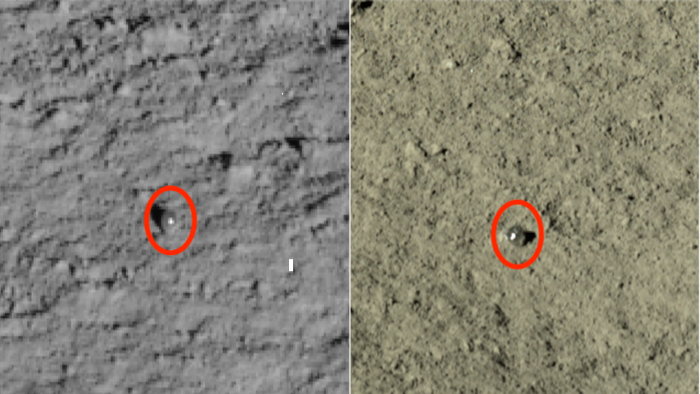China rover spots strange glass spheres on far side of the moon
Scientists think the spheres were made by a recent meteor impact.

China's Yutu-2 rover has spotted two strange glass spheres on the far side of the moon.
Glistening like translucent pearls against the moon's dry and dusty landscape, the lunar "spherules"' are the first of their kind to be found on the lunar surface and formed fairly recently, researchers say.
Glass has been spotted on the moon before; by both the Yutu-2 rover and NASA’s Apollo 16 mission. It forms when silicon-rich minerals, such as pyroxene and feldspar, are rapidly superheated.
However, this is the first time glass spheres have been found on the moon. Scientists don't know the exact origins of these spherules, but they think the little balls, or globules, may have been made during an explosive eruption in the moon's volcanic history or after a high-speed impact with a meteorite. The researchers will publish their findings Feb. 26 in the journal Science Bulletin.
Related: 5 strange, cool things we've recently learned about the moon
"The globules simply blow our mind, since they are so unique on the moon," lead author Zhiyong Xiao, a planetary geologist at Sun Yat-sen University in China, said in a statement. "It is a bit unfortunate that when we first found these glasses, the rover had just passed by them and no compositional data were obtained, but such globules might be pretty common at the lunar farside."
Glass spherules, also known as microtektites, have been found on Earth around the sites of meteorite impacts, Live Science previously reported. Upon being struck by a meteorite, chunks of planetary crust are thrown up into the air, and the molten silicate minerals contained therein combine to form tiny glass beads that are sprinkled like crumbs over the surrounding landscape.
Get the world’s most fascinating discoveries delivered straight to your inbox.
The recently discovered microtektites, measuring 0.6 to 1 inch (15 to 25 millimeters) in diameter, are larger than those found on Earth. However, they are smaller than the glass chunks that Apollo 16 astronauts found near an impact crater on the moon's near side, the largest of which measured 1.57 inches (40 mm) in diameter
The microtektites discovered by Yutu-2 were also found near impact craters, leading the researchers to believe that the tiny spheres formed from a feldspar-rich igneous rock, called anorthosite, that melted and reformed in the immediate aftermath of a meteor collision.
"The first discovery of macro-sized translucent glass globules on the moon confirms that lunar anorthosites are excellent raw materials to manufacture glasses with good light-admitting quality," Xiao said. "Their existence on the moon indicates that impact events on the other planetary bodies could also form tektite-like impact glasses."
Collecting these ball-bearing-like spheres and studying their composition and ages could help scientists understand the impact history of the moon, as well as provide useful information about potential building materials on the lunar surface.
"At the dawn of constructing human bases to the moon, lunar anorthosites are a promising and widespread resource," Xiao said.
The Yutu-2 rover, whose name means "jade rabbit" in Mandarin, was launched from China's Chang'e 4 lunar lander in January 2019 after successfully completing the first-ever soft landing on the moon's far side. Trundling across the moon's 115-mile-wide (186 kilometers) Von Kármán crater, the rover's short time on our lunar neighbor has been eventful. During that time, the rover has taken a detailed scan beneath the moon's surface, spotted a mysterious "gel-like" substance believed to be more lunar glass and even glimpsed an object that first appeared to be a mysterious hut but was later revealed as a rabbit-shaped rock.
Chang'e 4 is China's fourth mission to the moon and its second to land a rover on the lunar surface. China also landed its Zhurong rover on Mars last year and is currently building the Tiangong space station, which is set for completion by the end of 2022. China has also declared that it will establish a lunar research station on the moon's south pole by 2029.
A much-less-controlled lunar landing of a Chinese spacecraft is projected to take place on March 4, when a now-defunct rocket stage from a 2014 moon mission is expected to smash into the moon's surface while traveling at 5,771 mph (9,288 km/h), Live Science previously reported.
Originally published on Live Science.

Ben Turner is a U.K. based writer and editor at Live Science. He covers physics and astronomy, tech and climate change. He graduated from University College London with a degree in particle physics before training as a journalist. When he's not writing, Ben enjoys reading literature, playing the guitar and embarrassing himself with chess.


